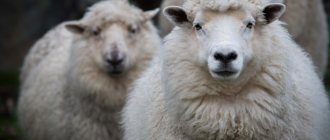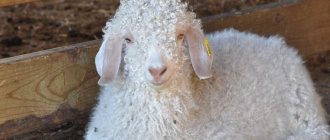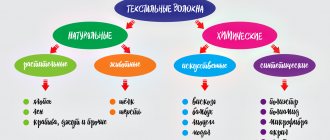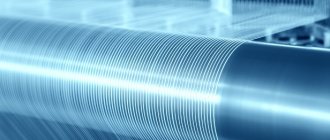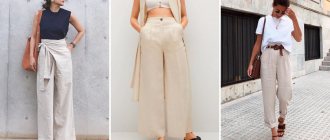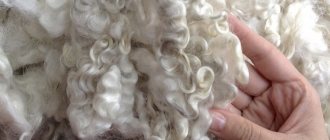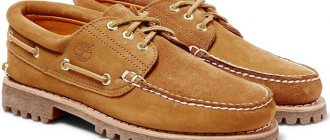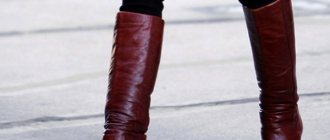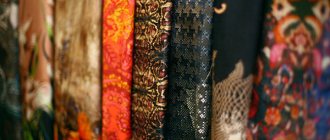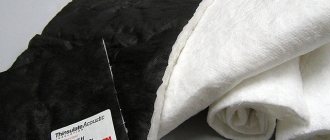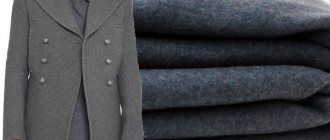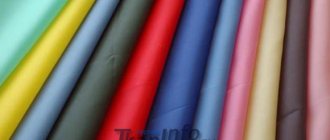Artificial wool - what is it, description, properties
A material obtained artificially, very similar to natural wool - this is artificial wool.
Initially, this material was obtained from scraps of half-woolen and woolen products. They were crushed, processed and new products were created. This allowed us to save on goods.
Currently, this wool replacement is made from viscose , a material based on cellulose that is turned into fibers by pressing through filters. The resulting fibers are dried, pressed, bleached and dyed. Then it is ground again and turned into yarn, from which artificial fabric is subsequently obtained. It is also called “acrylic” or “vistra”.
As mentioned earlier, this material has a number of similarities to real wool. They are similar both in appearance and to the touch, only acrylic is softer.
Positive qualities of the material
Vistra has a number of advantages, namely :
- Ability to take on different forms. Thanks to this, it can replace wool or half-wool and make threads of various thicknesses from it.
- Strength. Items made from acrylic can serve the owner for a long time due to their wear resistance, tolerate washing well, and retain their shape. Such products are not subject to fading. A big plus is that they practically do not wrinkle and, as a result, do not need ironing.
Artificial wool has a high resistance to atmospheric phenomena, for example, long-term overheating of 120–130 degrees.
- Softness. We all know that natural wool is a little rough, itchy and biting, which cannot be said about acrylic. It is pleasant to the touch and lacks the above-mentioned qualities.
- Ability to stretch. It is expressed in high resistance to deformation, but it is an elastic material.
- Ease. Vistra is not heavy and does not cause discomfort when worn.
- Water repellency. There is little chance of getting wet in an acrylic product.
- It stains well, which allows for greater contrast and promotes long-term color retention.
- Hypoallergenic. It is believed that artificial wool does not cause allergies; this is a real salvation for people with hypersensitivity to real wool. Not being able to wear things made from natural material, they can easily replace it with acrylic.
The material is recommended for the production of children's clothing. Children often suffer more severely from allergy symptoms, so their sensitivity must be treated with increased attention.
- Low thermal conductivity. Due to this, the vistra retains heat well and is perfect for creating winter clothes.
Minuses
There are not many disadvantages of acrylic, but we must not forget about them.
- High electrification of fibers. Probably everyone has encountered the fact that clothes sometimes “shock”, and this is not very pleasant.
- Low ability to absorb moisture. If the ability to repel water is a plus, then in a too stuffy room a person may feel discomfort.
To avoid these problems, artificial wool is mixed with natural wool and cotton, but this option is not suitable for people with allergies.
- Formation of "pellets" . Alas, this drawback did not escape this material, but it is expressed relatively weakly.
Popular wool fabrics and their uses
Currently, there are many woolen fabrics, both pure and with impurities. Wool fabrics have a variety of uses, depending on the density of the fabric, weave and even color. The most commonly used fabrics are:
- Fleece is a type of woolen fabric, a soft, dense fabric with thick brushed pile. Used for sewing demi-season coats .
- Boucle is a thick wool fabric with a knotted surface that has excellent heat-insulating properties. Used for sewing outerwear.
- Velor is a type of woolen fabric characterized by thick short pile and soft. Used for making outerwear and hats. There are several types.
- Gabardine is a type of woolen fabric with a small inclined rib, produced from the highest grades of carding yarn. Quite lightweight and water resistant. Suits , men's and women's demi-season and summer coats are made from it .
- Jersey is a woolen knitted fabric, characterized by softness, and is considered a material of wide application. Used for sewing dresses, skirts, suits, coats.
- Drape is a type of woolen fabric, heavy, dense, with thick pile, made from fluffy yarn. Outerwear is made from this fabric.
- Jacquard is a patterned wool fabric used for sewing women's coats and suits.
- Crepe is a thin, heavy wool fabric that has a grainy surface because it is made from high-twist threads. Draps well, ideal for sewing dresses.
- Plush is a type of woolen fabric with a pile on the front side, used for sewing soft toys, upholstery and clothing.
- Rep is a woolen fabric with transverse or longitudinal ribs, used for sewing dresses and suits.
- Broadcloth is a single-layer wool fabric with a matte surface. It is used for sewing jackets, jackets, skirts and some types of outerwear.
- Tweed is a soft woolen fabric with a loose structure made from variegated melange yarn. Used for sewing women's suits, men's jackets and coats.
- Felt is a woolen material that is obtained by felting the fluff of rabbits, hares, and sheep wool. Hats and shoes are made from felt .
- Flannel is a soft, double-brushed wool fabric. Flannel is used to sew dresses and suits.
- Tartan is the most famous woolen fabric with a check pattern. Used for sewing warm men's shirts, children's and women's clothing.
Where is artificial wool used?
Acrylic is mainly used to create clothing and various accessories. In addition, it is used to produce things needed in everyday life (blankets, pillows, etc.).
What to wear with warm stockings?
What is superwash wool?
History of creation
The first mentions of wool are found in ancient civilizations, as far back as 1500 BC. she was famous and in great demand. Fun fact: wild goat fur has been found in caves and mountains in Georgia as far back as 34,000 years ago. In addition, in Ancient Rome, wool was in demand along with other fabrics: leather and linen. Wool producers who took special care of their sheep always sold out because their wool was of superior quality and beautiful appearance.
In the Middle Ages, wool production was established, starting in the 13th century. some countries in the world exported wool and thus made good profits. By the end of the 14th century. Italy was one of the world leaders in wool sales. Around the same time, wool production was also developing in Great Britain, various laws were issued to control the wool trade, and at a certain stage wool seriously competed with silk.
However, as soon as synthetic fibers began to appear on the fabric market, the high demand for wool began to decline. According to the observations of some analysts, since 1966, the cost of wool has fallen by almost 40%, thus, at the same time, the production of this fabric has also decreased. In the 70s, manufacturing technology changed; wool was specially processed, so this fabric could be machine washed.
In the mid-2000s, the UN brought attention to natural fabrics by declaring 2009 the Year of Natural Fibers. This allowed for some increase in demand for this fabric.
Around the same time, a revolution occurred in the fashion world: a wool suit was made in Japan that was easy to wash, dry quickly and did not require ironing.
Points to consider when choosing an acrylic bedspread
Better suited for decorating a room and protecting bed linen from dust. A blanket and bedspread have poor contact with the body (since the fabric does not absorb moisture), sleeping under such a product can be uncomfortable and dangerous due to overheating and rotting.
A blanket with short cut pile, due to its low price and positive properties of the fabric, is also suitable for the floor when you have to organize a place for children to play. Then the simplest blanket of decent quality will serve you well.
Knitted blankets will help create a stylish and elegant room, so they will work as an accent, aesthetic element of decor. In this case, look for elegant, fashionable patterns and thoughtful prints that will look beautiful even when draped in pleats.
How is acrylic made?
Acrylic blankets are made from acrylonitrile, a colorless, flammable liquid that comes from plastic. It mixes with other chemicals. The mixture is then either injected into the air-filled space and dried, or sprayed into water. Then the fibers are washed and dried. At this stage the fibers are either long "tug" fibers or short "staple" fibers such as wool or cotton. Both types of acrylic fiber are used to weave fabrics, but with different appearances.
Buying an acrylic blanket
There are quite a few affordable blankets with nice designs on the market. Among the main ones are:
- flower arrangements;
- abstract geometric shapes;
- imitation animal skin;
- classic patterns;
- photorealistic prints.
The most popular sizes: 160 by 220 and 200 by 240.
A blanket of the first size can be found from 1200 rubles, and a second size - from 1500 rubles. With imitation of small or large knitting they will be more expensive, from 2 thousand.
What disadvantages should be considered?
These disadvantages are more significant for acrylic in clothing. The blanket does not come into contact with the body so often and is actively used. However, you need to be aware of some disadvantages:
- airtightness;
- waterproofness, which is also a disadvantage: because of this, it collects static electricity in a dry room and can easily ignite from direct fire.
- formation of pellets with frequent use if the material is of low quality;
- When exposed to the sun, the fabric becomes rougher.
Wild treasure of Mongolia
“Cashmere, camel and yak down are not really wool,” says Odonchimeg Yongdon , an entrepreneur from Mongolia. — This is the undercoat of a camel, yak or goat (cashmere). The materials are unique - there is nothing lighter or warmer. Camel also contains lanolin, which penetrates the human body through the pores of the skin and has a beneficial effect on health. All materials are very delicate - if you walk on the floor in camel socks, they will wear out in a week. But if the clothes are not subject to friction, they can be worn for years.”
Article on the topic
Clothes for health: which fabrics are good to wear and which ones are the opposite
The listed types of wool are the most expensive; Let's say a cashmere cardigan is unlikely to be cheaper than 15-20 thousand rubles. “The price of the product, by the way, sometimes helps to identify a fake,” notes Odonchimeg. “For example, socks made of camel wool cannot cost 250-300 rubles - their retail price is at least 600.”
The main reason for the high cost is the difficulty of obtaining raw materials. Camels, goats and yaks are semi-wild animals. To comb out the fluff, you must first catch them. And if it is not difficult to catch and tie a goat, a camel is more difficult, but possible, then no one can hold a yak. And the production time is also sharply limited.
